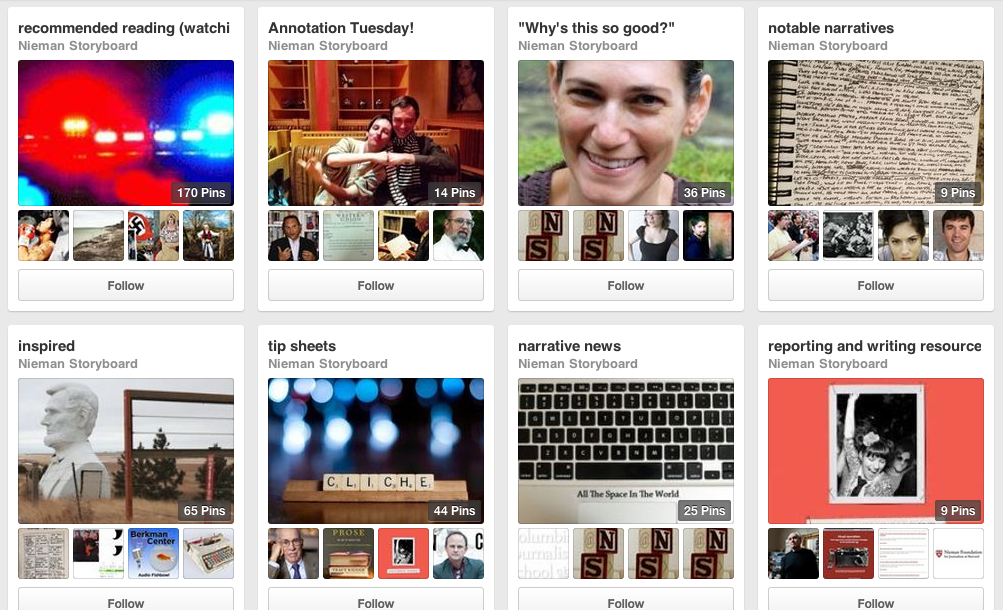Pinned this week for your storytelling pleasure: pieces on a jailhouse boxer, an old triple homicide in Texas, a billion dollars’ worth of recovered European art, a one-day writing conference and organizational tips.
From Recommended Reading:
The Paris Review’s Clifford Chase with a study in cadence. From “A Downward Glissando:”
 From Brin-Jonathan Butler and Kurt Emhoff’s “Gold in the Mud” (SB Nation), on the prison boxer James Scott:
From Brin-Jonathan Butler and Kurt Emhoff’s “Gold in the Mud” (SB Nation), on the prison boxer James Scott:
Michael Hall deepens the Texas Monthly franchise on narratives about old killings and wrongful convictions with “The Murders at the Lake,” about a triple homicide, in Waco, in 1982. Excerpt:
Alex Shoumatoff, of Vanity Fair, tells the story of 1,280 art works, stolen by the Nazis, discovered in the apartment of a recluse. Shoumatoff writes:
From our Narrative News board:
The Columbia Journalism School and The Big Roundtable announced a one-day conference, “When Bad Things Happen to (Your) Good Stories,” for May 31. The lineup includes the New York Times’ Andrea Elliott, a Pulitzer-winning narrative journalist; Nieman alum Dexter Filkins, author of The Forever War; and Steve Kandell, the longform editor at BuzzFeed. Price, $295. J-school alums get a 10 percent discount.
From Gear:
ICYMI, The Open Notebook’s Christie Aschwanden hails the Planner Pad as an organizational must-have:
From Recommended Reading:
The Paris Review’s Clifford Chase with a study in cadence. From “A Downward Glissando:”
The name of the medication printed in a half circle and the “100 mg” made a smiley face on my new, blue pills.
On the L train, a poem called “Hunger” spoke of walking home “through a forest that covers the world.”
I’d had the same part-time public-relations job since November 1985. It was now February 2001 and counting.
I was drawn to Neil Young not by the specific content of the lyrics (too hetero) but by the overall tone of longing, which I defined as a kind of sadness that had hope.
On the L platform, a diminutive Chinese man playing “Send in the Clowns” on a harmonica, with flowery recorded accompaniment.
 From Brin-Jonathan Butler and Kurt Emhoff’s “Gold in the Mud” (SB Nation), on the prison boxer James Scott:
From Brin-Jonathan Butler and Kurt Emhoff’s “Gold in the Mud” (SB Nation), on the prison boxer James Scott:The late comedian George Carlin once said, "It's called the American Dream because you need to be asleep to believe it." But locked in a 5-by-9 cell, behind maximum-security walls, a 6'1, 175-pound living nightmare of a jailhouse fighter had his own American Dream and he wanted it televised nationwide. For a short time, that dream instilled enough fear that it gave the light heavyweight champion insomnia. Promoter Don King, sports' most successfully rehabilitated ex-con, himself a man who newspaper columnist turned novelist and screenwriter Pete Dexter once described as "easiest to imagine as a disease," someone who "for 15 cents will put boys in the ring and girls on the street," wouldn't go near this convict's request to promote his next fight. Even King, Mr. "Only in America!" in all his devious genius, couldn't believe any fighter, let alone the public, would want any role in the twisted saga of James O. Scott.
Michael Hall deepens the Texas Monthly franchise on narratives about old killings and wrongful convictions with “The Murders at the Lake,” about a triple homicide, in Waco, in 1982. Excerpt:
The criminal trials for the lake murders were the most anticipated in Waco’s history. Throughout the spring of 1984, an endless string of pretrial hearings dominated the local papers; in nightly broadcasts, Waco’s citizens were regaled with details of the defendants’ shady pasts, including the rumor that Spence was a Satan worshipper. In April district judge George Allen made a decision: Spence would be tried first, followed by Gilbert, Tony, and then Deeb. Each man was charged with three counts of capital murder, and each would stand first for the killing of Jill Montgomery.
Alex Shoumatoff, of Vanity Fair, tells the story of 1,280 art works, stolen by the Nazis, discovered in the apartment of a recluse. Shoumatoff writes:
Cornelius Gurlitt was a ghost. He had told the officer that he had an apartment in Munich, although his residence—where he pays taxes—was in Salzburg. But, according to newspaper reports, there was little record of his existence in Munich or anywhere in Germany. The customs and tax investigators, following up on the officer’s recommendation, discovered no state pension, no health insurance, no tax or employment records, no bank accounts—Gurlitt had apparently never had a job—and he wasn’t even listed in the Munich phone book. This was truly an invisible man.
From our Narrative News board:
The Columbia Journalism School and The Big Roundtable announced a one-day conference, “When Bad Things Happen to (Your) Good Stories,” for May 31. The lineup includes the New York Times’ Andrea Elliott, a Pulitzer-winning narrative journalist; Nieman alum Dexter Filkins, author of The Forever War; and Steve Kandell, the longform editor at BuzzFeed. Price, $295. J-school alums get a 10 percent discount.
From Gear:
ICYMI, The Open Notebook’s Christie Aschwanden hails the Planner Pad as an organizational must-have:
The brilliant thing about the daily to do list is that it has only ten lines, which means that you cannot commit yourself to doing more than ten things. At first, I thought ten lines weren’t enough, but over time, I’ve learned that ten things are often too many. The to-do lists I’d been making were way too long; I was setting myself up for failure. Now, I take a minimalist approach. I set myself up for success by aiming to create daily lists that I can finish, and I measure my success by whether or not I’ve crossed everything off the list by the end of the day. As a result, my daily to-do list has grown much shorter.


